Distinguishing Features: Identification of House, Purple, and Cassin’s Finches
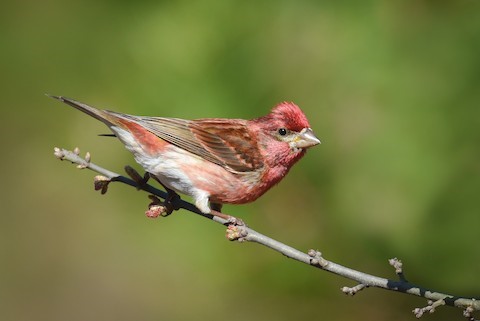
Male Purple Finch—misleadingly named, as they are not truly purple. © Scott Martin
Males of the three North American Haemorhous finches—House, Purple, and Cassin’s—could all be described as raspberry-stained (or blood-stained, as the genus name Haemorhous implies). Females are brown and streaked. Each species is quite variable in the details of its plumage patterns and coloration, and individuals of both sexes can be difficult to distinguish from the other species. They present a well-known identification challenge for the birdfeeding public. The House Finch (H. mexicanus), is far more familiar than the other two over most of North America, so it is usually the presumptive default, with the others being uncommon exceptions.
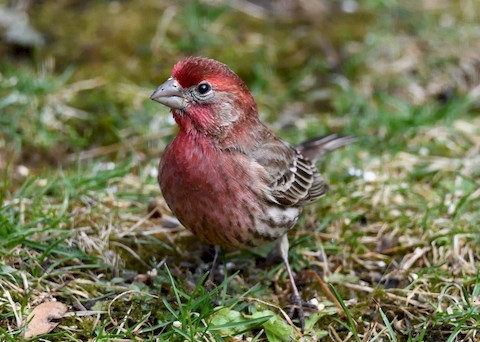
Male House Finch showing rosy coloration similar to male Purple Finch—but note the bold brown streaks on the flanks. (Peterborough, Ontario; April 19, 2020.) © Matthew Garvin
Geography and habitat are often good indicators. In the breeding season, the areas of overlap are very limited. House is an abundant resident of settled areas and lightly wooded lowlands from southern Canada to southern Mexico. Purple Finch (H. purpureus) breeds in the northern forest belt across Canada and New England and south along the Pacific Coast to southern California. Cassin’s Finch (H. cassinii) occurs mainly at upper elevations of the interior mountains from British Columbia to northern Baja California. In winter, however, Purple moves south across most of the continental U.S., and Cassin’s moves downslope and south across the western U.S. and northern Mexico, so both overlap with House and to a lesser extent with one another.
Male House Finch. The male House Finch is probably the most variable of the Haemorhous finches, so it is difficult to generalize accurately. The typical male shows a more scarlet or orangish shade of red than the other males, mostly concentrated on the face (as a “visor” from forehead to eyebrows), throat, and chest. The top of the crown is usually brown. It can sometimes be red, but not as red as on the eyebrows, throat, and chest.
The male Purple and Cassin’s show a consistently rosy shade of red that is brightest on the crown—with other differences that can vary confusingly. Some male House Finches also appear rosy-red, depending on lighting and individual variation, so the tone is less diagnostic than the pattern.
The variability of male House Finch coloration is extreme. Some are reddish-brown, some are mostly red, some appear orange instead of red, some are more yellow, and they can be many shades in between.
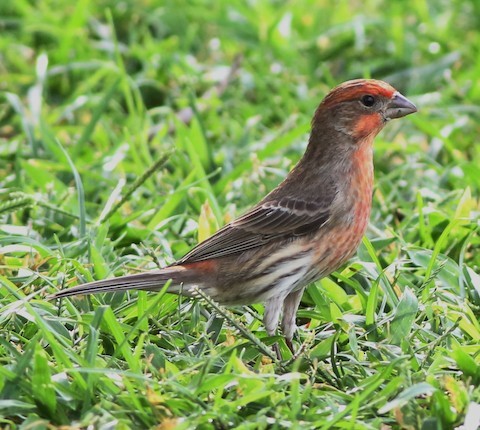
Male House Finch with typical orangish-red coloration, brown back, and boldly streaked flanks. (Fort Derussy Beach Park, Honolulu, Hawaii; December 19, 2017.) © Derek Stokes
Unlike male Purple, the male House Finch has a mostly brown back. Unlike most male Purples and all male Cassin’s, it has broad brown streaks on the flanks. This feature is often cited to differentiate House and Purple, but some male Purples show similar streaking on the flanks.

Male House Finch with a subtle rosy blush. (Pullman, Washington; October 2, 2020.) © Mason Maron
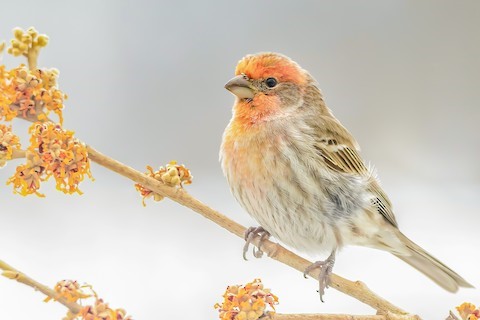
Male House Finch with orange replacing typically red plumage. (Newark, Ohio; February 20, 2021.) © Matthew Plante
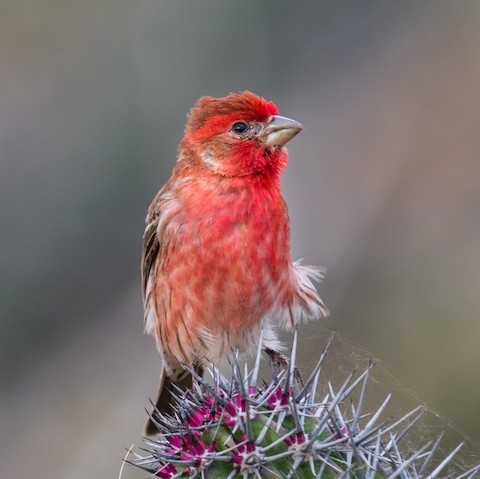
Male House Finch with abnormally vivid scarlet coloration—note that the red is most vivid on the forehead, brow, and throat. (La Paz, Baja California Sur, Mexico; March 13, 2020.) © Jim Merritt
Male Purple Finch. The male Purple Finch has a vivid rosy-red forecrown and is extensively brownish-red and pink elsewhere—not purple anywhere. It is brownish-red on most of the upperparts, including a large dark streak across its face and a smaller dark whisker streak. The rest of the face, throat, and breast are typically some shade of pink or rosy red.
The flanks usually show blurred brownish-red streaks. This feature varies from being all-pinkish without streaks to boldly streaked brown—with the majority somewhere in between. Regionally, the westernmost (near-Pacific) populations tend to appear browner and more streaked, whereas northern and eastern populations tend to be pinker and blurred, without distinct streaks on the flanks. As a result, confusion with male House Finch is more likely in the West.

Male Purple Finch, showing mostly rosy coloration. (Westmount, Ontario; October 3, 2020.) © Laure Wilson Neish
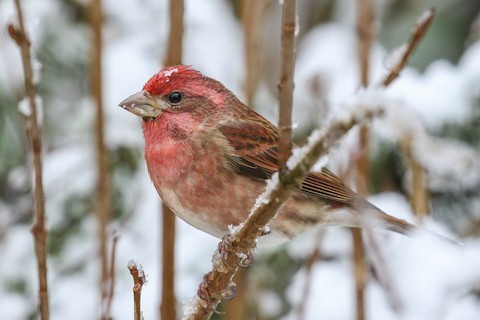
Male Purple Finch, showing dark brown streaks on the flanks. (Nanaimo, British Columbia; January 8, 2019.) © Blair Dudeck
Male Cassin’s Finch. The male Cassin’s Finch is much like the male Purple Finch, but somewhat paler below and plainer overall. It has a vivid rosy-red crown, and otherwise mostly either pale reddish-brown or pale pink. Its facial pattern is essentially identical to Purple’s, and their facial coloration is approximately the same. Because Cassin’s is plainer overall, the red forecrown stands out against the rest of its plumage.
Male Cassin’s most differs from Purple in the general coloration of the back and underparts. Cassin’s has a distinctly streaked back with contrasting dark and pale feathers, and Cassin’s usually shows mostly whitish underparts with a pink blush that is dominant only on the throat and chest.

Male Cassin’s Finch. (Alta, Utah; March 18, 2021.) © William Richards
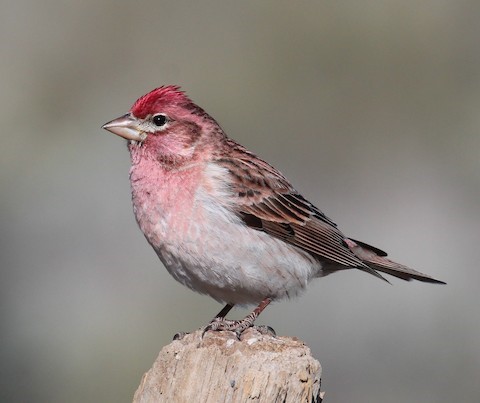
Male Cassin’s Finch. (Cabin Lake, Oregon; May 15, 2017.) © Milton Vine
The underparts are mostly either pale pink or white, and unstreaked except for the undertail coverts, which usually have sparse brown streaks—unlike male Purple. However, many male Cassin’s have no apparent streaks on the undertail, so this is not a reliable distinction.
Two clues that often help recognize Cassin’s are bill shape and habitat. Cassin’s has a long, sharp-tipped bill that appears neatly triangular—its profile is drawn with straight lines. For the most part, Cassin’s is a resident of mountain forests, usually at higher elevations than Purple and House, although they overlap to some degree, especially in winter.

Female House Finch with washed out, grayish coloration. (London, Ontario; October 20, 2020.) © Laure Wilson Neish
Female House Finch. The female House Finch is plain brown and streaked throughout—among the plainest, streakiest birds there is. The streaks are generally dense and blurred, often somewhat more distinct and broader on the breast. Unlike females of the other Haemorhous finches, it rarely shows a distinct eyebrow or whisker on the head.
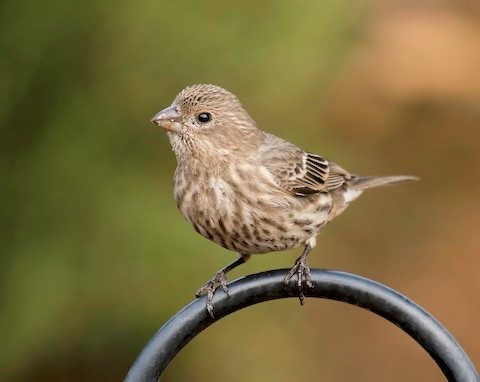
Female House Finch with boldly streaked underparts. (Escondido, California; February 14, 2021.) © Alison Davies
Female Purple Finch. The female Purple Finch is mostly brown above, with a distinct head pattern and bold, blurred streaks on white underparts. The head pattern consists mostly of a dark facial stripe or patch, with a whitish eyebrow (often only behind the eye), a broad whitish whisker mark, and a heavily streaked throat.
The head pattern is usually strong and noticeable enough to separate female Purple from female House—although some individuals are more blurred, like female House. Head pattern alone is rarely sufficient to distinguish female Purple from Cassin’s.

Female Purple Finch with comparatively washed-out, pale-brown-and beige plumage. (Kunkle Reservoir, Butte County, California; November 16, 2020.) © Liam Huber
A more consistent distinction between female Purple and Cassin’s is the breadth and crispness of streaking on the underparts—Purple tends to have broader, blurrier streaks with less white area among them. As in most features, however, there is enough individual variation within each species that they overlap substantially.
Female House and Purple often show approximately the same broad, blurred streaks, but they tend to differ in overall distribution. Purple’s streaks tend to be denser on the chest and flanks, but the belly is all or mostly white. Again, however, individual variation within species is such that many individuals of one species show a pattern that would be more typical of the other species.
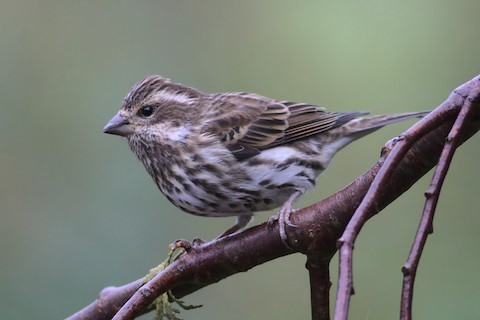
Female Purple Finch showing strong head pattern and boldly streaked underparts. (Addison, Vermont; September 30, 2020.) © David Guertin

Female Purple Finch with bold head pattern and boldly, but sparsely, streaked underparts. (Houston, Texas; December 27, 2020.) © James Rieman
Female Cassin’s Finch. The female Cassin’s Finch is approximately intermediate between Purple and House, with some individuals that are difficult to distinguish from one or the other. Many show a strong facial pattern similar to that of female Purple, and many show a weaker pattern that could be consistent with female house.
Female Cassin’s tends to have narrower, more sharply defined streaks on the underparts than either Purple or House—but all three species vary somewhat in the boldness and crispness of these streaks, so they likely overlap to some extent.
As with the males, montane habitat is often the first clue, and the sharp-tipped, straight-edged, triangular bill shape is often noticeable. At times, however, the best or only confirmation of female Cassin’s is the close association of male Cassin’s in a pair or flock.

Female Cassin’s Finch showing bold, dark streaking both above and below, and somewhat weak head pattern. (Moose Visitor Center, Jackson County, Colorado; April 21, 2019.) © Shelley Rutkin
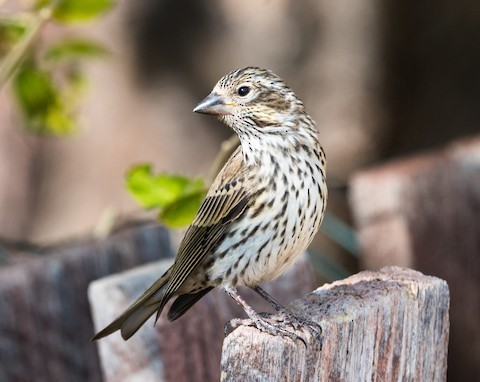
Female Cassin’s Finch showing narrow, sharply defined streaks on the underparts and a strong head pattern—perhaps more likely an immature male, based on yellowish tones and strong facial markings. (Norwood, Colorado; October 24, 2020.) © Jim Merritt
References
Alderfer, J., and J.L. Dunn. 2014. National Geographic Complete Birds of North America (Second Edition). National Geographic Society, Washington, D.C.
Clement, P., A. Harris, and J. Davis. 1993. Finches and Sparrows: An Identification Guide. Princeton University Press.
eBird. 2021. eBird: An online database of bird distribution and abundance. Cornell Lab of Ornithology, Ithaca, N.Y. http://www.ebird.org. (Accessed October 13, 2021.)
Howell, S.N.G., and S. Webb. 1995. A Guide to the Birds of Mexico and Northern Central America. Oxford University Press, Oxford.
Sibley, D.A. 2014. The Sibley Guide to Birds (Second Edition). Alfred A. Knopf. New York.
Text © Russell Fraker / October 13, 2021